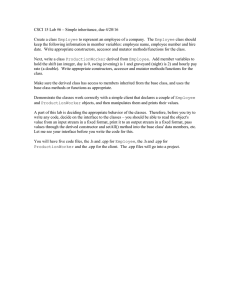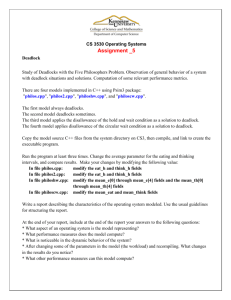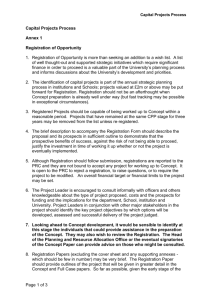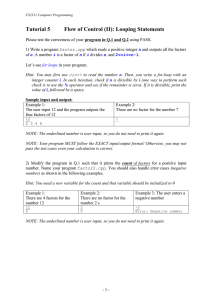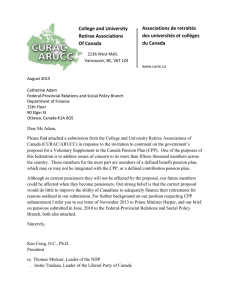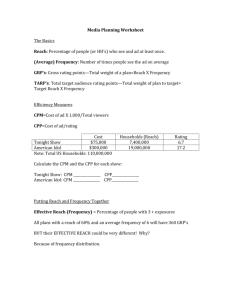case studies Fixed-mobile interconnection Ben Petrazzini
advertisement
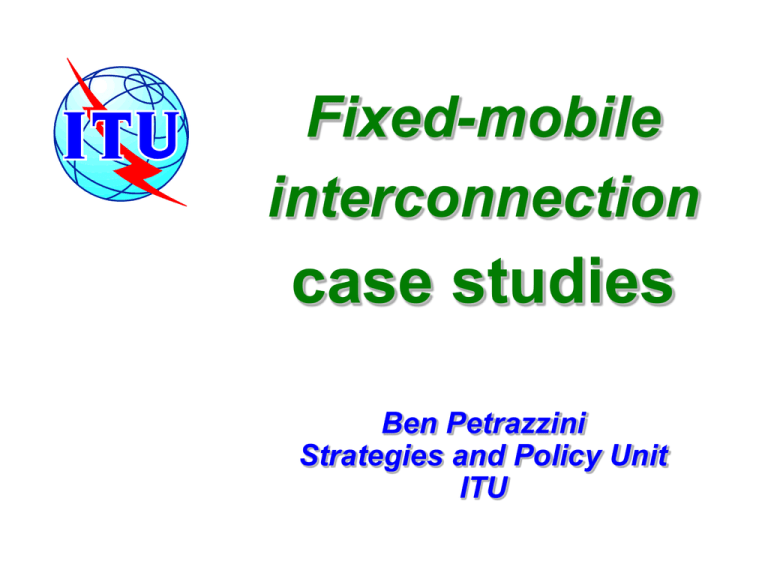
Fixed-mobile interconnection case studies Ben Petrazzini Strategies and Policy Unit ITU Agenda Brief market profile FMI basics Main issues Experiences and “lessons” from the cases Summary and conclusions China’s market profile Population: 1’256 million GDP per capita: US$ 768 Teledensity: 8.59% Ownership of incumbents: Public Competition in LD & int.: 1999 Mobile density 3.41% Competition in mobile 1993 Finland’s market profile Population: 5.15 million GDP per capita: US$ 20’100 Teledensity: 55.2% Ownership of incumbents: private [%] Competition in LD & int.: 1994 Mobile density 65.2% Competition in mobile 1990 India’s market profile Population: 1’000 million GDP per capita: US$ 475 Teledensity: 2.28% Ownership of incumbents: public Competition in local: 1994 Competition in LD: 2000 Mobile density 0.12% [98] Competition in mobile 1994 Mexico’s market profile Population: 95.8 million GDP per capita: US$ 4’216 Teledensity: 11.3 [6-00] Ownership of incumbents: private Competition in local: 1990 Competition in LD, int: 1997 Mobile density 10.6 [6-00] Competition in mobile 1992 The diverstiy of FMI basics China: M pays F F pays M [1/8 of M to F] Finland: Each segment charged separately India: M pays F F does not pay M Mexico: M pays F F pays M [70% more than M to F] Some key FMI issues Economic Asymetries and wide variation of prices Lack of price setting transparency CPP vs. RPP Fixed-mobile cross-subsidy Role of competition Technical Links, POIs, Quality of services etc. Legal/institutional Institutional legacies and inertias dispute resolution Ownership and interconnection ECONOMIC ISSUES Asymmetric F/M charges PSTN to PSTN PSTN to mobile Ratio Spain 0.02 0.52 22.29 Germany 0.04 0.77 21.00 Sweden 0.03 0.56 16.80 France 0.03 0.50 15.00 Switzerland 0.04 0.58 14.50 Netherlands 0.04 0.53 13.25 Belgium 0.04 0.48 11.08 Some studies (e.g., ECTA) argue that 70% of the cost of fixed to mobile calls are on call termination Asymmetric F/M charges: Mexico Caller pays To fixed To mobile Fixed to mobile 40c 20c 20c Mobile to fixed 28c 25c 3c Mobile prepaid card users pay: 58c Note: prices in US$ Asymmetric F/M charges: Finland Fixed local charges Mobile charges Note: prices in US$ Sonera Elisa 0.072 call + 0.0058 min 0.048 call + 0.0066 min 0.0037 ->10 min 0.25 [peak] 0.16 [off-peak] 0.25 [peak] 0.16 [off-peak] Asymmetric F/M charges Internat. to USA Local to a mobile Mexico US$ 0.46 US$ 0.40 Switzerland CHF 0.12 CHF 0.55 Note: prices per minute CPP vs. RPP FMI charges average (US$) 0.092 CPP 0.056 Fixed-to-mobile interconnection rate 0.005 RPP 0.009 0 0.02 Mobile-to-fixed interconnection rate 0.04 0.06 0.08 0.1 CPP vs. RPP & FMI charges In most CPP markets premium imposed on the fixed caller by the fixed-line operator = non-transparent prices No choice of termination carrier = lack of incentives for lower FMI charges In RPP markets Pricing more transparent Mobile operator has incentives to lower prices Billing and collection in CPP Bad debt: Finland Billing and collection: Mexico M-operators proposal US$ 0.022 Telmex proposal US$ 0.135 Rate set by Telmex US$ 0.064 p/ mon. p/subsc. US$ 6.0 Does CPP pricing affect fixed traffic? Does CPP pricing undermine the growth of mobile services? Impact of CPP on fixed traffic India: Attempt to introduce CPP Reduced F to M charge (3.90 to 2.40) & reduced share (15/85 to 50/50) Then CPP delayed/blocked Mexico: Minutes of traffic per month by cell subscriber Cellular traffic After CPP 12/99 83 Variation Outgoing Before CPP 03/99 89 Incoming 73 94 29% Total 162 177 9% -7% Impact of CPP on cel subscribers 4'500 fixed & mobile users added each year, 000s 4'000 Main lines 3'500 Mexico Mobile subscribers 3'000 CPP introduced 2'500 2'000 Pre-paid introduced 1'500 1'000 500 0 1991 1992 1993 1994 1995 1996 1997 1998 1999 Impact of CPP on cel subscribers millions Growth of mobile subscribers 4 Argentina 3 Introduction of CPP 2 1 0 89 90 91 92 93 94 95 96 97 98 99 Are F-M charges a x-subsidy? Are high FMI charges just the product of CPP implementation in a market-driven and non-transparent environment? Do they constitute an implicit crosssubsidy? If yes, do they constitute a desirable and necesary cross-subsidy? India: fixed users poorer than mobile users. Reason for courts to overtun CPP? Mexico & Venezuela: mobile users poorer than fixed line users? CPP led to growth of mobile services for the poor? Why pay more for the minute? Mexico, subscribers by contract type, millions 5 Pre-paid plan "Amigo" 4 3 2 Contract plans 1 0 1995 1996 1997 1998 1999 Who is disconecting the fixed line? 1'000 Venezuela, thousands Main lines 800 Mobile subscribers 600 400 200 0 -200 1990 1991 1992 1993 1994 1995 1996 1997 1998 Role of competition Does the licensing of more operators affect FMI interconnection rates? OECD, Mexico: yes; India: unclear Does the definition of market power have any effect? Finland and EU: yes; Others: unclear TECHNICAL ISSUES Links and POIs Bi-directional or uni-directional links Mexico: Telmex uni-directional links approach • Telmex no incentive to invest in new links. Traffic congestion and quality of service problems • Reason: billing Single or multiple POIs India: Single POIs per SSA • TRAI 1997 order for multiple POIs – no implementation Quality of service Mexico: the impact of CPP • Mobile density leaped from 1.8 in 1997 to 7.5 in 1999, to 11 in June 2000. Other technical matters China Slow business approval process Limited mobile switching center coverage Dedicated gateways for interconnection Per unit [3 min.] charging scheme Unfavorable routing plan Signaling and billing Quality of service deficiencies Emergency service interconnection INSTITUTIONAL ISSUES The importance of regulators Economic matters Market per se lacks of incentives to bring interconnection charges down to costs Long interconnection negotiations Technical matters points of interconnection Intitutional matters Institutional legacies and inertia Ownership and interconnection conditions Slow dispute resolution THANK YOU!
